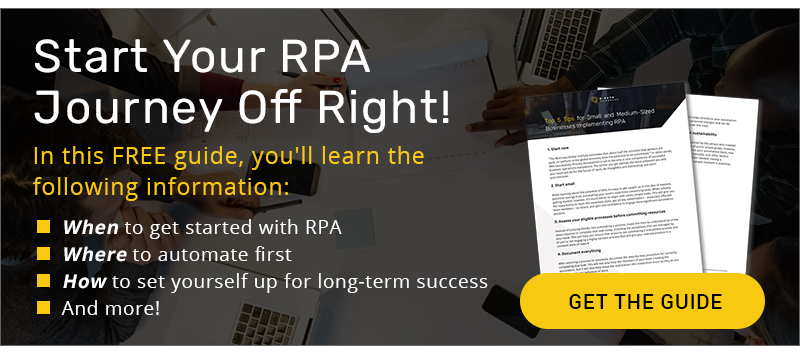Intelligent Automation (IA), which includes Robotic Process Automation (RPA) and Artificial Intelligence, makes virtually every top tech trends list in the past few years. Understanding the potential of these technologies is essential for every business leader looking to prepare for the future of work.
But then what? Just understanding the technology won’t transform your business. You need to embrace the opportunity, develop an implementation plan with your team, and take action. Of course, that’s easier said than done! If you’re feeling unsure of how to approach this incredible technology for your business, here’s a four-stage framework that will help you get started, including some of the common pitfalls to avoid.
Stage 1 – Pilot
Start with an RPA pilot. The purpose of the pilot is not to prove the technology works – the evidence speaks for itself – but to establish credibility and help people become more comfortable with RPA within your organization. Executive stakeholders will want to see cost savings; they will want to see data that can be used in building a business case. Employees will want firsthand experience with automation before they truly feel at ease with the concept. So remember these objectives when you plan your pilot, and work hard to avoid these common mistakes:
- Starting too big – Some people feel that they need to automate the most complicated use case in order to validate the technology, but the reality is that this will send the project on a collision course with failure.
- Going cheap – Many automation platform providers will tell you that anyone can program a “bot,” and it’s tempting to use internal resources. Unless you have an existing development team, however, you’ll be facing too many unknowns to deliver effective results. Find someone with experience to serve as your guide and help you get started.
Stage 2 – Task Automation
Now it’s time to grow your automation skillset by knocking out some low-hanging fruit. Once you’ve had a successful pilot, a handful of other tasks will present themselves as obvious candidates for automation. Do it! At this point, you have three, key objectives:
- Build a constituency of automation advocates within your organization
- Develop guidelines and best practices for bot governance
- Reduce hours spent on low–value work
The problems many organizations run into at this stage are:
- Declaring success too soon – Some companies go overboard with task automation and declare victory. They have delivered a robust ROI and feel like that’s all there is to automation. They don’t realize how much they’re leaving on the table.
- Saving solely on paper – You’ve freed up 4,000 hours of work a year and don’t feel like any of that has translated into real, bottom–line savings.
Both issues stem from the fact that your automation efforts so far have been tactical. Intentionally so, but now it’s time to get strategic!
Stage 3 – Process Automation
The first two stages are all about establishing your baseline understanding of the technology, developing your skills, and achieving some quick wins. Now it’s time to think bigger!
As any good process engineer will tell you, streamlining a task may have no impact on the actual throughput of the process. Instead, it will merely move the constraint from one part of the process to another.
At this point, you need to start looking at your business strategically. Instead of simply deciding which tasks can be automated, you need to zoom out and determine in what area of the business you need to see an improvement and identify how automation can help you achieve that goal.
This stage requires you to further develop your capabilities as you begin a digital transformation of your business. You’re connecting automatable and non-automatable tasks together into streamlined, end-to-end processes that positively move the needle.
The pitfalls some companies find during this stage include:
- Starting here too quickly – Digital transformation is hard and often unsuccessful, and that’s even more likely when companies avoid the first two stages and miss the opportunity to rally their team around the goal. There is always resistance to change, but if you have all the right stakeholders on board, success is much more likely.
- Not establishing a Center of Excellence (CoE) – Companies that fail to establish a CoE and clear guidelines for bot governance find themselves stuck in a classic “too many cooks in the kitchen” scenario.
- Failing to document – A critical, first step in this stage is to model the process to be transformed. Many business leaders think they know how their businesses run, but few fully appreciate the level of customization and/or shortcuts that their teams exercise each day.
Stage 4 – Business Transformation
By this point, you’ve made dramatic improvements to your business, but there’s yet further to go! Where you were once constrained by what you’ve always done, it’s now time to ignite your team’s collective imagination and consider what’s possible.
You have a completely new set of capabilities in your organization, and your culture has fully adopted automation as the new norm. The question you need to ask is, “What can we do now that was never possible in the past?”
The race for digital transformation is happening across industries and between companies of all sizes. The leaders and fast followers that embrace Intelligent Automation technologies will enjoy enormous benefits, so don’t delay in getting started.
